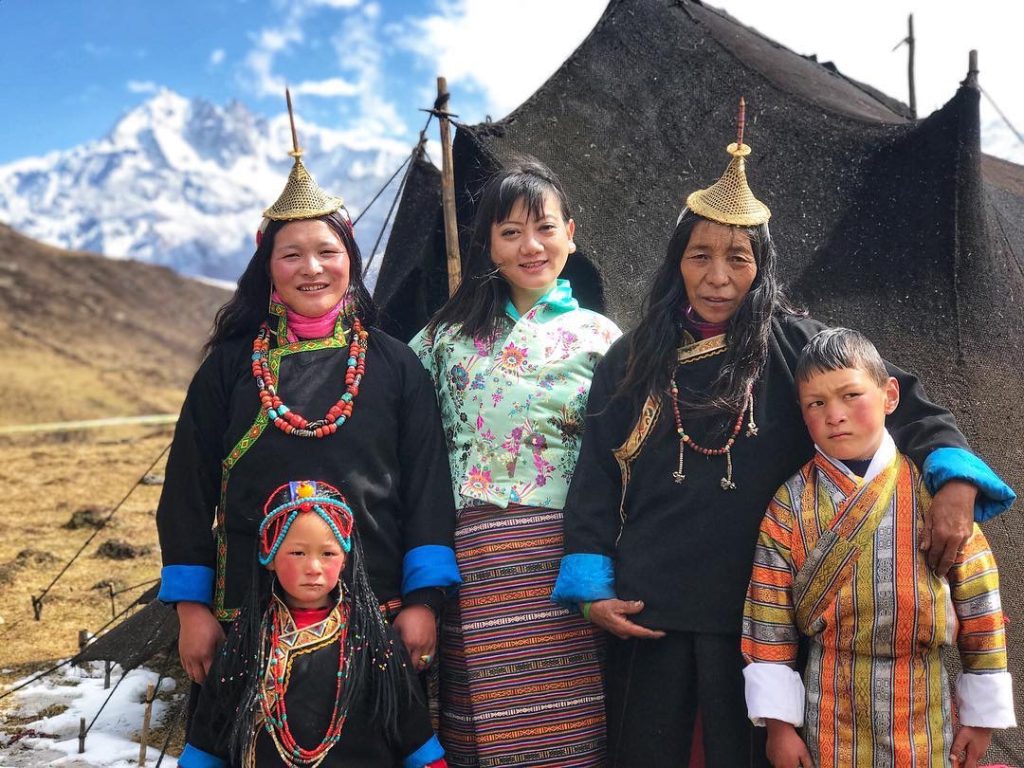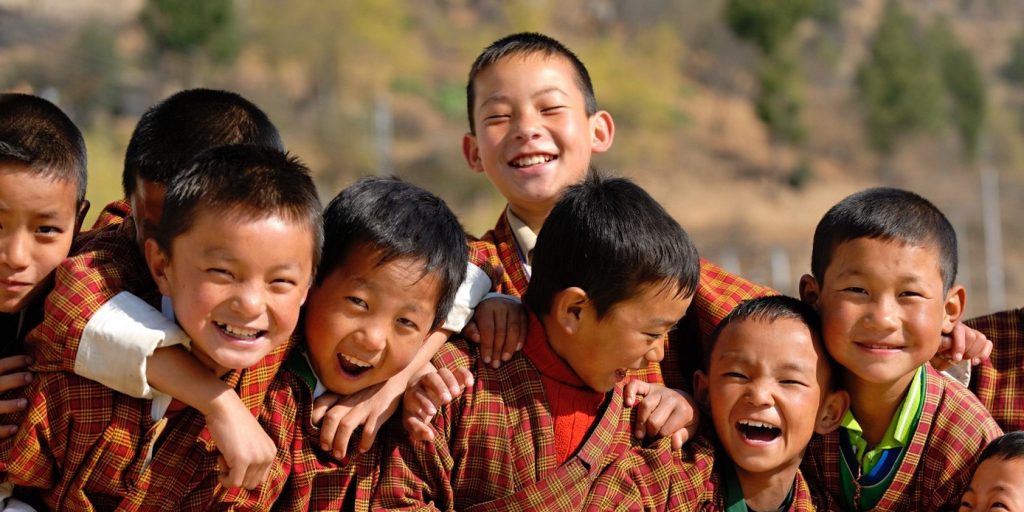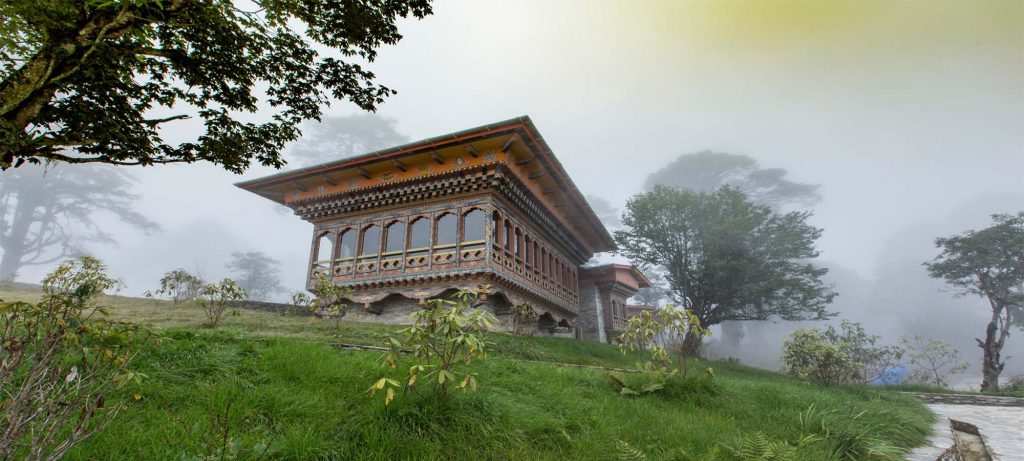History of Bhutan

Bhutan, the Kingdom of Bhutan is a landlocked country in the Eastern Himalayas. It is bordered by China to the north and India to the south. Nepal and Bangladesh are located in proximity to Bhutan but do not share a land border. The country has a population of over 754,000 and a territory of 38,394 square kilometers (14,824 sq mi) which ranks 133rd in terms of land area, and 160th in population. Bhutan is a constitutional monarchy with Vajrayana Buddhism as the state religion.
The subalpine Himalayan mountains in the north rise from the country’s lush subtropical plains in the south. In the Bhutanese Himalayas, there are peaks higher than 7,000 meters (23,000 ft) above sea level. Gangkhar Puensum is Bhutan’s highest peak and may also be the highest unclimbed mountain in the world. The wildlife of Bhutan is notable for its diversity, including the Himalayan takin. The largest city in Bhutan is the capital Thimphu.
Bhutanese People

Bhutanese people can be generally categorized into three main ethnic groups. The Tshanglas, Ngalops and the Lhotshampas.
Tshanglas: The Tshanglas or the Sharchops as they are commonly known as, are considered the aboriginal inhabitants of eastern Bhutan. According to historians, Tshanglas are the descendants of Lord Brahma and speak Tshanglakha. They are commonly inhabitants of the eastern part of the country. Weaving is a popular occupation among their women and they produce beautiful fabrics mainly of silk and raw silk.
Ngalops: The Ngalops who have settled mostly in the six regions of western Bhutan are of Tibetan origin. They speak Ngalopkha, a polished version of Dzongkha, the national language of Bhutan. Agriculture is their main livelihood. They cultivate cereals such as rice, wheat, barley and maize along with a variety of other crops. They are known for Lozeys, or ornamental speech and for Zheys, dances that are unique to the Ngalops.
Lhotshampas: The Lhotshampas have settled in the southern foothills of the country. They speak Lhotshamkha (Nepali) and practice Hinduism. Their society can be broken into various lineages such as the Bhawans, Chhetris, Rai’s, Limbus, Tamangs, Gurungs, and the Lepchas. Nowadays they are mainly employed in agriculture and cultivate cash crops like ginger, cardamom and oranges.
The other minority groups are the Bumthaps and the Khengpas of Central Bhutan, the Kurtoeps in Lhuentse, the Brokpas and the Bramis of Merak and Sakteng in eastern Bhutan, the Doyas of Samtse and finally the Monpas of Rukha villages in WangduePhodrang. Together the multiethnic Bhutanese population number just over 700,000.
Gross National Happiness

Economists all over the world have argued that the key to happiness is obtaining and enjoying material development. Bhutan however, adheres to a very different belief and advocates that amassing material wealth does not necessarily lead to happiness. Bhutan is now trying to measure progress not by the popular idea of Gross Domestic Product but through Gross National... Happiness.
While conventional development models stressed on economic growth as the ultimate objective, the concept of Gross National Happiness is based on the premise that true development of human society takes place when material and spiritual development occur side by side to complement and reinforce each other.
While the emphasis is placed on both, prosperity and happiness, the latter is considered to be more significant. Thus, Gross National Happiness is now being fleshed out by a wide range of professionals, scholars and agencies across the world.
The philosophy of Gross National Happiness has recently received international recognition and the UN has implemented a resolution “recognizing that the gross domestic product does not adequately reflect the happiness and well-being of people”, and that “the pursuit of happiness is a fundamental human goal”
Bhutanses Cuisine

The most distinctive characteristic of Bhutanese cuisine is its spiciness. Chillis are an essential part of nearly every dish and are considered so important that most Bhutanese people would not enjoy a meal that was not spicy.
Rice forms the main body of most Bhutanese meals. It is accompanied by one or two side dishes consisting of meat or vegetables. Pork, beef and chicken are the meats that are eaten most often. Vegetables commonly eaten include Spinach, pumpkins, turnips, radishes, tomatoes, river weed, onions and green beans. Grains such as rice, buckwheat and barley are also cultivated in various regions of the country depending on the local climate.
Religion

The Bhutanese constitution guarantees freedom of religion and citizens and visitors are free to practice any form of worship so long as it does not impinge on the rights of others. Christianity, Hinduism and Islam are also present in the country.
Buddhism: Bhutan is a Buddhist country and people often refer to it as the last stronghold of Vajrayana Buddhism. Buddhism was first introduced by the Indian Tantric master Guru Padmasambhava in the 8th century. Until then the people practiced Bonism, a religion that worshiped all forms of nature, remnants of which are still evident in some remote villages in the country.
With the visit of Guru Padmasambhava, Buddhism began to take firm roots within the country and this especially led to the propagation of the Nyingmapa (the ancient or the older) school of Buddhism.
Phajo Drugom Zhigp from Ralung in Tibet was instrumental in introducing yet another school of Buddhism – the Drukpa Kagyu sect. In 1222 he came to Bhutan, an event of great historical significance and a major milestone for Buddhism in Bhutan, and established the DrukpaKagyu sect of Buddhism, the state religion. His sons and descendants were also instrumental in spreading it to many other regions of western Bhutan.
By far the greatest contributor was Zhabdrung Nawang Namgyal. His arrival in 1616 from Tibet was another landmark event in the history of the nation. He brought the various Buddhist schools that had developed in western Bhutan under his domain and unified the country as one whole nation-state giving it a distinct national identity.
The Buddhism practiced in the country today is a vibrant religion that permeates nearly every facet of the Bhutanese life style. It is present in the Dzongs, monasteries, stupas, prayer flags, and prayer wheels punctuate the Bhutanese landscape. The chime of ritual bells, sound of gongs, people circumambulating temples and stupas, fluttering prayer flags, red robed monks conducting rituals stand as testaments to the importance of Buddhism in Bhutanese life.
Culture

[depicter id="3"]
While Bhutan is one of the smallest countries in the world, its cultural diversity and richness are profound.
As such, strong emphasis is laid on the promotion and preservation of its unique culture. By protecting and nurturing Bhutan’s living culture it is believed that it will help guard the sovereignty of the nation.
Eating Habits
Traditional Bhutanese eating habits are simple and, in general, food is eaten with hands. Family members eat while sitting cross legged on the wooden floor with food first being served to the head of the household first.
It is usually women who serve the food and in most cases, the mother. Before eating, a short prayer is offered and a small morsel placed on the floor as an offering to the local spirits and deities. With modernization, eating habits have changed and in urban areas, people usually eat with cutlery whilst seated at a regular dining table.
Traditionally dishes were cooked in earthenware, but with the easy availability of modern goods, pots and pans have largely replaced their use. A typical Bhutanese meal consists of rice, a dish of Ema Datshi, the country’s favourite dish of chili and cheese, pork, beef curry or lentils.
Funeral
Death signifies re-birth or a mere passing on to a new life. In keeping with the traditions, elaborate rituals are performed to ensure a safe passage and a good rebirth.
The 7th, 14th, 21st and 49th days after a person’s death are considered especially important and are recognized by erecting prayer flags in the name of the deceased and performing specific religious rituals. While the deceased are normally cremated, funerary practices vary in few cases. In some parts of the country, people typically bury their dead while in some, they carry out ‘Sky Burials’, a process in which the deceased are prepared and left atop mountains to be devoured by vultures in a final act of compassion and generosity. Elaborate and ancient rituals are also conducted on the anniversary of the death with the erection of prayer flags. The relatives and people of the locality come with alcohol, rice or other sundry items to attend such rituals.
Birth
The birth of a child is always welcomed. In Bhutan extended family and guests are discouraged from visiting during the first three days after the birth.
On the third day, a short purification ritual is performed after which visitors are welcomed to visit the new born and mother. Bhutanese value children as progenitors of the future and therefore do not discriminate on the sex of the child. Traditionally various gifts are offered ranging from dairy products to cloth and money.
The child is not immediately named; this responsibility is usually entrusted to the head lama (Buddhist priest) of the local temple. The mother and child will also receive blessings from the local deity (natal deity) and it was traditional that the name associated with the deity is given. In some cases, the child is given the name of the day on which the child is born. Based on the Bhutanese calendar, a horoscope is written based on the time and date of the birth, this will detail the various rituals to be performed at different times in the life of the child and to an extent predict his or her future.
Marriage
Until just a few decades ago arranged marriages were common and many married among their relatives. In eastern Bhutan cross-cousin marriages were also once common, however, this practice is now becoming less common place among the literate masses and most marriages are based on the choice of the individuals.
Marriages are simple affairs and are usually kept low-key. However, elaborate rituals are performed for lasting unions between the bride and the bridegroom. As the religious ceremony comes to an end, parents, relatives and friends of the couple present the newlyweds with traditional offerings of scarves along with gifts in the form of cash and goods.
In the Western Bhutan, it was commonplace that the husband goes to live in his wife’s house after marriage while the practice in Eastern Bhutan is for the wife to move into the husband’s home. Of course, the newlyweds may also choose to live on their own. Divorce is also an accepted norm and carries no ignominy or disgrace within the country.
Bhutanese Dress
One of the most distinctive features of the Bhutanese is their traditional dress : a unique garments that have evolved over thousands of years. Men wear the Gho, a knee-length robe somewhat resembling a kimono that is tied at the waist by a traditional belt known as Kera. The pouch which forms at the front traditionally was used for carrying food bowls and a small dagger. Today however it is more accustomed to carrying small articles such as wallets, mobile phones and Doma (beetle nut).
Women wear the Kira, a long, ankle-length dress accompanied by a light outer jacket known as a Tego with an inner layer known as a Wonju.
However, tribal and semi-nomadic people like the Bramis and Brokpas of eastern Bhutan generally wear clothing that differs from the rest of the Bhutanese population. The Brokpas and the Bramis both wear dresses woven either out of Yak or Sheep hair.
Bhutanese wear long scarves when visiting Dzongs and other administrative centers. The scarves worn vary in color, signifying the wearer’s status or rank. The scarf worn by men is known as Kabney while those worn by women are known as Rachus. .
The Rachu is hung over a woman’s shoulder and like the scarves worn by men, they too have specific rank associated with their color. Rachus are usually woven out of raw silk and embroidered with beautiful rich patterns.
Bhutanese Festivals
Bhutan is rich in cultural diversity and this richness ....is further enhanced by the wide variety of elaborate and colorful religious festivals that are celebrated throughout the country. Every village is known for their unique festival though the most widely known is the annual Tshechu, an annual religious festival.
As the Tshechu begins, the villagers and the general populace dress in their finest clothes and congregate at their local temples and monasteries where these festivals take place. Tshechus are usually occasions to mark important events in the life of the second Buddha, the Indian/Pakistani Tantric master known as Guru Rinpoche or the Precious Master. Various mask dances are performed together with songs and dances for three days on average.
These religious celebrations are lively, high-spirited affairs during which people share meals of red rice, spicy pork, Ema Datshi and Momos (pork/beef dumplings) whilst drinking the heady traditional rice wine known as Ara. These occasions provide the villagers with a respite from the hard labor of their day to day lives and gives the community an opportunity to catch up with family and friends
Climate

The climate in Bhutan is extremely varied, which can be attributed to two main factors-the vast differences in altitude present in the country and the influence of North Indian monsoons.
Climatic Zones of Bhutan
Southern Bhutan has a hot and humid subtropical climate that is fairly unchanging throughout the year. Temperatures can vary between 15-30 degrees Celsius (59- 86 degrees Fahrenheit). In the Central parts of the country which consists of temperate and deciduous forests, the climate is more seasonal with warm summers and cool and dry winters. In the far Northern reaches of the kingdom, the weather is much colder during winter. Mountain peaks are perpetually covered in snow and lower parts are still cool in summer owing to the high altitude terrain.
Seasons
Bhutan has four distinct seasons in a year.
The Indian summer monsoon begins from late-June through July to late-September and is mostly confined to the southern border region of Bhutan. These rains bring between 60 and 90 percent of the western region's rainfall. Annual precipitation ranges widely in various parts of the country. In the Northern border towards Tibet, the region gets about forty millimeters of precipitation a year which is primarily snow. In the temperate central regions, a yearly average of around 1,000 millimeters is more common, and 7,800 millimeters per year has been registered at some locations in the humid, subtropical south, ensuring the thick tropical forest, or savanna.
Bhutan's generally dry spring starts in early March and lasts until mid-April. Summer weather commences in mid-April with occasional showers and continues to late June. The heavier summer rains last from late June through late September which are more monsoonal along the southwest border.
Autumn, from late September or early October to late November, follows the rainy season. It is characterized by bright, sunny days and some early snowfalls at higher elevations.
From late November until March, winter sets in, with frost throughout much of the country and snowfall common above elevations of 3,000 meters. The winter northeast monsoon brings gale-force winds at the highest altitudes through high mountain passes, giving Bhutan its name - Drukyul, which means Land of the Thunder Dragon in Dzongkha (the native language).
Average Temperatures in Bhutan
It should be noted that average temperatures are recorded from valley floors. There can be considerable divergences from the recorded figures depending upon elevation.
Flora & Fauna
Bhutan is listed as one among the top 10 biodiversity hot spots in the world. Bhutan has total forest coverage of over 70% of the country's total geographical area with the constitution requiring 60% of the country under forest coverage for all times to come.
The array of flora and fauna available in Bhutan is unparalleled due to conservation and its wide altitudinal and climatic range. Physically, the country can be divided into three zones:
1. Alpine Zone (4000m and above) with no forest cover;
2. Temperate Zone (2000 to 4000m) with conifer or broadleaf forests;
3. Subtropical Zone (150m to 2000m) with Tropical or Subtropical vegetation.
Forest types in Bhutan are fir forests, mixed conifer forest, blue pine forest, chirpine forest, broadleaf mixed with conifer, upland hardwood forest, lowland hardwood forest, and... tropical lowland forests. Almost 60% of the plant species found in the eastern. Himalayan region is present in Bhutan.
Bhutan boasts of about 300 species of medicinal plants and about 46 species of rhododendrons. Some common sights for... the visitors are the magnolias, junipers, orchids of varied hues,... gentian, medicinal plants, Daphne, giant rhubarb, the blue and trees such as fir, pine, and oaks.
A wide range of rare and endangered animals can also be found frequenting the dense jungles and high mountains of Bhutan. Due to the countries conservation efforts and its unspoiled natural environment, Bhutan supports thriving populations of some of the rarest animals on earth and has thus been classified as one of the last biodiversity hotspots in the world.
Some high altitude species are the snow leopards, Bengal tigers that are found at altitude ranging 3000 to 4000 meters, the red panda, the gorals and the langurs, the Himalayan black bear, sambars, wild pigs, barking deer, blue sheep and musk deer.
In the tropical forests of Southern Bhutan, one can come across clouded leopards, the one-horned rhinoceros, elephants, water buffaloes, and swamp deer. You can even find the Golden Langur, a species of monkey that is unique to Bhutan.